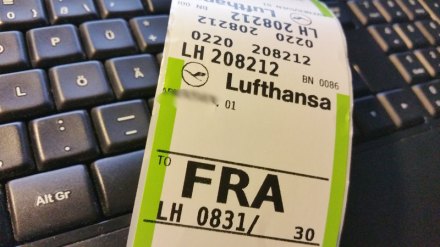
I will continue the exploration of the basic components of the blockchain technology started in the previous post, where I implemented a basic java class to visualize hashing and the linking of blocks (chain). To provide a sample for the aviation industry walking along the use-case of tracking the baggage custody changes during a flight journey .
3. Validation
A blockchain need to be validated otherwise we would not know if data was changed or corrupted. We have to iterate through the sequence of blocks, for this we create an array of bag transactions to allow easy iteration and compare the stored hash of each block with the recalculated hash. If the values match the blockchain is valid, if not it is corrupted (and all subsequent blocks). Ideally this would be event-driven, any change to the blockchain triggers the revalidation. In a real-world implementation changes through the endpoints would not be possible, something we will look at later when working with Corda or Ethereum.
String currentBagBlockHash = "0";
String myBagTag = randomBagTagID();
String myPNR = randomPNR();
ArrayList allBagTransactions = new ArrayList();
BagTransaction tempBagTransaction = null;
// Print Bag Tag (Genesis Block)
tempBagTransaction = new BagTransaction(myBagTag, myPNR, Entity.NIL.name(), Entity.PAX.name(), 0, "0");
currentBagBlockHash = tempBagTransaction.getHash();
allBagTransactions.add(tempBagTransaction);
...
public void checkBlockchainIntegrity(ArrayList allBagTransactions) {
// Check Blockchain. Compare recalculated hash with hash attribute stored
for (BagTransaction b : allBagTransactions){
System.out.print("Block " + b.getBlockID() + " Stored Hash: " + b.getHash() + " -- Calculated Hash:" + b.createHash());
if (b.getHash().equals(b.createHash()))
System.out.println(" -- OK");
else
System.out.println(" -- FAIL. Blockchain broken.");
}
System.out.println(" -- ");
}
}
For better reading we convert each block into a JSON object.
{
"timeStamp": "2018-08-26T09:18:09.227Z",
"blockID": 0,
"blockHash": "ce41abbf21a162152e30fc511eaf594db43c84948691d12ef78fad6f31fa6043",
"previousBlockHash": "0",
"bagTag": "5347241966",
"pnr": "EONT9T",
"custodyTransfer": [
{"transferFrom": "NIL"},
{"transferTo": "PAX"}
]
}
{
"timeStamp": "2018-08-26T09:18:09.287Z",
"blockID": 1,
"blockHash": "6b6073122ef996acc1e3c3e74c3963b5903112800781b4ba88e96baf0a8e2e04",
"previousBlockHash": "ce41abbf21a162152e30fc511eaf594db43c84948691d12ef78fad6f31fa6043",
"bagTag": "5347241966",
"pnr": "EONT9T",
"custodyTransfer": [
{"transferFrom": "PAX"},
{"transferTo": "AIRP"}
]
}
Running the validation for a clean and corrupted blockchain
Block 0 Stored Hash: ce41abbf21a162152e30fc511eaf594db43c84948691d12ef78fad6f31fa6043 -- Calculated Hash:ce41abbf21a162152e30fc511eaf594db43c84948691d12ef78fad6f31fa6043 -- OK Block 1 Stored Hash: 6b6073122ef996acc1e3c3e74c3963b5903112800781b4ba88e96baf0a8e2e04 -- Calculated Hash:6b6073122ef996acc1e3c3e74c3963b5903112800781b4ba88e96baf0a8e2e04 -- OK Block 2 Stored Hash: a33bbb5ebdec589e9f1b7c7952d6fef3fae2235b5a0600b8755b07040bba8227 -- Calculated Hash:a33bbb5ebdec589e9f1b7c7952d6fef3fae2235b5a0600b8755b07040bba8227 -- OK Block 2 Stored Hash: 464319fed3a2c49df9a1fbeedae3f3e7c6692db0f6ab97a4c983f9fdf4269e6d -- Calculated Hash:464319fed3a2c49df9a1fbeedae3f3e7c6692db0f6ab97a4c983f9fdf4269e6d -- OK -- Now corrupt Block 1 by changing the data Block 0 Stored Hash: ce41abbf21a162152e30fc511eaf594db43c84948691d12ef78fad6f31fa6043 -- Calculated Hash:ce41abbf21a162152e30fc511eaf594db43c84948691d12ef78fad6f31fa6043 -- OK Block 1 Stored Hash: 6b6073122ef996acc1e3c3e74c3963b5903112800781b4ba88e96baf0a8e2e04 -- Calculated Hash:09fd4223571f079258bd69d935f99cb552cd3ac0854410b81a2313d215929ebd -- FAIL. Blockchain broken.
4. Mining Blocks
Now we get to the first more complex concepts of the blockchain, the mining process. We are still operating at a very basic level though with a single node, but we can introduce the mining operation. Without going into too much detail, mining blocks is the step to close/hash a block and creating a new one as part of the consensus process. The incentive to the miner community is a transaction fee given to that miner that solves a hard cryptographic problem first. The more computing power you invested in, the higher chance you have as miner to solve the problem and get the fee. Based on scarcity this consensus approach is called Proof-of-Work (recommended reading). Unfortunately this lead to the current hardware race consuming vast amount of energy for literally no purpose (you let CPU/GPU’s guess numbers basically). This is seen as limitation, together with the long transaction times, and some blockchain start to move to other concepts, such as Proof-of-Stake.
Breaking down the Proof-of-Work to a simple algorithm, we build a hash function that need to create a certain pattern before being accepted. The hash of (data current block + hash previous block + a nonce value) need to have a number of leading “0” in front. The number of “0” is the difficulty and the nonce is an integer value that is changed/increased until the hash matches the required pattern.
public String mineHash(int difficulty) {
String returnHash = "";
String tempHash = "";
String target = new String(new char[difficulty]).replace('\0', '0');
tempHash = createHash();
while (!tempHash.substring(0, difficulty).equals(target)) {
nonce++;
tempHash = createHash();
}
return tempHash;
}
With a growing difficulty (more leading “0”) it takes obviously longer to crack the challenge and with more CPU power you can run through the guessing cycle faster. Some samples below with increasing difficulty running on an ordinary notebook i7 CPU (java executing on a single core/thread in this case).
Difficulty: 1
Attempts: 11
Milliseconds: 10
Difficulty: 2
Attempts: 393
Milliseconds: 30
Difficulty: 3
Attempts: 1.794
Milliseconds: 40
Difficulty: 4
Attempts: 115.756
Milliseconds: 230
Difficulty: 5
Attempts: 3.366.041
Milliseconds: 3.210
Difficulty: 6
Attempts: 5.322.279
Milliseconds: 4.530
Difficulty: 7
Attempts: 76.339.743
Milliseconds: 60.850
Block
{
"timeStamp": "2018-08-26T10:38:36.734Z",
"blockID": 0,
"blockHash": "0000000158d606c953a5df346d459aad949e9dbb4abe74f30ecf225c23112b14",
"previousBlockHash": "0",
"bagTag": "7821666095",
"pnr": "ZHY4RT",
"custodyTransfer": [
{"transferFrom": "NIL"},
{"transferTo": "PAX"}
]
}
Have a look at the below website for the current real life difficulty for bitcoin (hashing algorithm not implemented in the simple way we did it here for illustration purpose). Looking at the current difficulty (6,727,225,469,722) you can guess what kind of hardware setup you need to be fast. I gave up beyond difficulty 7 with the algorithm above.

Stay tuned for more blockchain.
Disclaimer: This discussion, datamodel and sourcecode or application is for study purpose solely. It does not reflect or replicate any existing commercial product.




